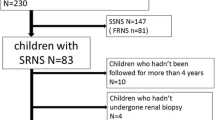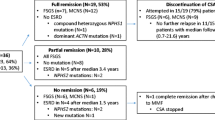Abstract
We present a retrospective study of 30 children of mean age 3.02 ± 1.81 years with steroid-resistant nephrotic syndrome (SRNS) treated with intravenous injection of methylprednisolone plus orally administered prednisone; 24 children also received cyclophosphamide (CP). Sixteen were resistant to steroids from the beginning, and 14 after a mean of 11.26 ± 16.61 months. The initial histological diagnosis was: 18 minimal change disease (MCD), 11 focal segmental glomerulosclerosis (FSGS) and one diffuse mesangial proliferative glomerulonephritis (DMPG). Total remission was achieved in 22 patients (73.3%), partial response in three (10%) and no response in five (16.6%), two of whom were brothers carrying an NPHS2 gene double mutation. There was no difference in response between the MCD and FSGS patients; the only patient with DMPG did not respond. Only initial resistance was a sign of bad prognosis. At follow-up (6.4 ± 3.6 years from last pulse), 21/22 were still in remission, 14/21 were without treatment. Six patients required cyclosporine or mycophenolate mofetil because of steroid dependence. Two non-responders developed end-stage renal failure (ESRF); the remaining patients maintained normal glomerular filtration. The treatment was well tolerated. In conclusion, most of the patients treated with sequential therapy consisting of methylprednisolone (MP) (100%) and CP (80%) showed remission and preserved renal function, but 20% developed steroid dependence.

Similar content being viewed by others
References
Koskimies O, Vilska J, Rapola J, Hallman N (1982) Long-term outcome of primary nephrotic syndrome. Arch Dis Child 57:544–548
Cattran DC, Rao P (1998) Long-term outcome in children and adults with classic focal segmental glomerulosclerosis. Am J Kidney Dis 32:72–79
Tarshish P, Tobin JN, Bernstein J, Edelmann CM Jr (1996) Cyclophosphamide does not benefit patients with focal segmental glomerulosclerosis. A report of the International Study of Kidney Disease in Children. Pediatr Nephrol 10:590–593
Tejani A (1985) Morphological transition in minimal change nephrotic syndrome. Nephron 39:157–159
Tejani A, Nicastri AD, Sen D, Chen CK, Phadke K, Adamson O, Butt KM (1983) Long-term evaluation of children with nephrotic syndrome and focal segmental glomerular sclerosis. Nephron 35:225–231
Mendoza SA, Reznik VM, Griswold WR, Krensky AM, Yorgin PD, Tune BM (1990) Treatment of steroid-resistant focal segmental glomerulosclerosis with pulse methylprednisolone and alkylating agents. Pediatr Nephrol 4:303–307
Hodson EM, Habashy D, Craig JC (2006) Interventions for idiopathic steroid-resistant nephrotic syndrome in children. Cochrane Database Syst Rev CD003594
International Study of Kidney Disease in Children (1974) Prospective, controlled trial of cyclophosphamide therapy in children with nephrotic syndrome. Report of the International study of Kidney Disease in Children. Lancet 2:423–427
Rose GM, Cole BR, Robson AM (1981) The treatment of severe glomerulopathies in children using high dose intravenous methylprednisolone pulses. Am J Kidney Dis 1:148–156
Tarshish P, Tobin JN, Bernstein J, Edelmann CM Jr (1997) Prognostic significance of the early course of minimal change nephrotic syndrome: report of the International Study of Kidney Disease in Children. J Am Soc Nephrol 8:769–776
Alshaya HO, Al-Maghrabi JA, Kari JA (2003) Intravenous pulse cyclophosphamide—is it effective in children with steroid-resistant nephrotic syndrome? Pediatr Nephrol 18:1143–1146
Hari P, Bagga A, Jindal N, Srivastava RN (2001) Treatment of focal glomerulosclerosis with pulse steroids and oral cyclophosphamide. Pediatr Nephrol 16:901–905
Yorgin PD, Krasher J, Al Uzri AY (2001) Pulse methylprednisolone treatment of idiopathic steroid-resistant nephrotic syndrome. Pediatr Nephrol 16:245–250
Tune BM, Kirpekar R, Sibley RK, Reznik VM, Griswold WR, Mendoza SA (1995) Intravenous methylprednisolone and oral alkylating agent therapy of prednisone-resistant pediatric focal segmental glomerulosclerosis: a long-term follow-up. Clin Nephrol 43:84–88
Mori K, Honda M, Ikeda M (2004) Efficacy of methylprednisolone pulse therapy in steroid-resistant nephrotic syndrome. Pediatr Nephrol 19:1232–1236
Kirpekar R, Yorgin PD, Tune BM, Kim MK, Sibley RK (2002) Clinicopathologic correlates predict the outcome in children with steroid-resistant idiopathic nephrotic syndrome treated with pulse methylprednisolone therapy. Am J Kidney Dis 39:1143–1152
Bajpai A, Bagga A, Hari P, Dinda A, Srivastava RN (2003) Intravenous cyclophosphamide in steroid-resistant nephrotic syndrome. Pediatr Nephrol 18:351–356
Schonwald S (1999) Methylprednisolone anaphylaxis. Am J Emerg Med 17:583–585
Saito R, Moroi S, Okuno H, Ogawa O (2004) Anaphylaxis following administration of intravenous methylprednisolone sodium succinate in a renal transplant recipient. Int J Urol 11:171–174
Butani L (2002) Corticosteroid-induced hypersensibility reactions. Ann Allergy Asthma Immunol 89:439–445
Latta K, von Schnakenburg C, Ehrich JH (2001) A meta-analysis of cytotoxic treatment for frequently relapsing nephrotic syndrome in children. Pediatr Nephrol 16:271–282
Ponticelli C, Rizzoni G, Edefonti A, Altieri P, Rivolta E, Rinaldi S, Ghio L, Lusvarghi E, Gusmano R, Locatelli F (1993) A randomized trial of cyclosporine in steroid-resistant idiopathic nephrotic syndrome. Kidney Int 43:1377–1384
Niaudet P (1994) Treatment of childhood steroid-resistant idiopathic nephrosis with a combination of cyclosporine and prednisone. French Society of Pediatric Nephrology. J Pediatr 125:981–986
Hymes LC (1995) Steroid-resistant, cyclosporine-responsive, relapsing nephrotic syndrome. Pediatr Nephrol 9:137–139
Sancewicz-Pach K, Slowiaczek E, Kwinta-Rybicka J, Wilkosz K, Drozdz D, Nowak J (1996) Long-term cyclosporine A (Sandimmun) therapy for steroid resistant nephrotic syndrome in children. Przegl Lek 53:365–368
Gregory MJ, Smoyer WE, Sedman A, Kershaw DB, Valentini RP, Johnson K, Bunchman TE (1996) Long-term cyclosporine therapy for pediatric nephrotic syndrome: a clinical and histologic analysis. J Am Soc Nephrol 7:543–549
Garcia C, Michelon T, Barros V, Mota D, Uhlmann A, Randon R, Ramalho H, Abbud FM (1998) Cyclosporine in the treatment of steroid-dependent and steroid-resistant idiopathic nephrotic syndrome in children. Transplant Proc 30:4156–4157
Habashy D, Hodson E, Craig J (2004) Interventions for idiopathic steroid-resistant nephrotic syndrome in children. Cochrane Database Syst Rev CD003594
El-Husseini A, El-Basuony F, Mahmoud I, Sheashaa H, Sabry A, Hassan R, Taha N, Hassan N, Sayed-Ahmad N, Sobh M (2005) Long-term effects of cyclosporine in children with idiopathic nephrotic syndrome: a single-centre experience. Nephrol Dial Transplant 20:2433–2438
Frassinetti Castelo Branco Camurca Fernandes P, Bezerra Da Silva G Jr, De Sousa Barros FA, Costa Oliveira CM, Kubrusly M, Evangelista JB Jr (2005) Treatment of steroid-resistant nephrotic syndrome with cyclosporine: study of 17 cases and a literature review. J Nephrol 18:711–720
Mahmoud I, Basuni F, Sabry A, El-Husseini A, Hassan N, Ahmad NS, Elbaz M, Moustafa F, Sobh M (2005) Single-centre experience with cyclosporin in 106 children with idiopathic focal segmental glomerulosclerosis. Nephrol Dial Transplant 20:735–742
McCauley J, Shapiro R, Ellis D, Igdal H, Tzakis A, Starzl TE (1993) Pilot trial of FK 506 in the management of steroid-resistant nephrotic syndrome. Nephrol Dial Transplant 8:1286–1290
McCauley J, Shapiro R, Scantlebury V, Gilboa N, Jordan M, Jensen C, Naik A, Tzakis A, Ellis D, Starzl TE (1991) FK 506 in the management of transplant-related nephrotic syndrome and steroid-resistant nephrotic syndrome. Transplant Proc 23:3354–3356
Segarra A, Vila J, Pou L, Majo J, Arbos A, Quiles T, Piera LL (2002) Combined therapy of tacrolimus and corticosteroids in cyclosporin-resistant or -dependent idiopathic focal glomerulosclerosis: a preliminary uncontrolled study with prospective follow-up. Nephrol Dial Transplant 17:655–662
Loeffler K, Gowrishankar M, Yiu V (2004) Tacrolimus therapy in pediatric patients with treatment-resistant nephrotic syndrome. Pediatr Nephrol 19:281–287
Tsugawa K, Tanaka H, Nakahata T, Ito E (2004) Effective therapy of a child case of refractory nephrotic syndrome with tacrolimus. Tohoku J Exp Med 204:237–241
Cattran DC, Wang MM, Appel G, Matalon A, Briggs W (2004) Mycophenolate mofetil in the treatment of focal segmental glomerulosclerosis. Clin Nephrol 62:405–411
Bagga A, Hari P, Moudgil A, Jordan SC (2003) Mycophenolate mofetil and prednisolone therapy in children with steroid-dependent nephrotic syndrome. Am J Kidney Dis 42:1114–1120
Barletta GM, Smoyer WE, Bunchman TE, Flynn JT, Kershaw DB (2003) Use of mycophenolate mofetil in steroid-dependent and -resistant nephrotic syndrome. Pediatr Nephrol 18:833–837
Day CJ, Cockwell P, Lipkin GW, Savage CO, Howie AJ, Adu D (2002) Mycophenolate mofetil in the treatment of resistant idiopathic nephrotic syndrome. Nephrol Dial Transplant 17:2011–2013
Chandra M, Susin M, Abitbol C (2000) Remission of relapsing childhood nephrotic syndrome with mycophenolate mofetil. Pediatr Nephrol 14:224–226
Mendizabal S, Zamora I, Berbel O, Sanahuja MJ, Fuentes J, Simon J (2005) Mycophenolate mofetil in steroid/cyclosporine-dependent/resistant nephrotic syndrome. Pediatr Nephrol 20:914–919
Fuchshuber A, Gribouval O, Ronner V, Kroiss S, Karle S, Brandis M, Hildebrandt F (2001) Clinical and genetic evaluation of familial steroid-responsive nephrotic syndrome in childhood. J Am Soc Nephrol 12:374–378
Karle SM, Uetz B, Ronner V, Glaeser L, Hildebrandt F, Fuchshuber A (2002) Novel mutations in NPHS2 detected in both familial and sporadic steroid-resistant nephrotic syndrome. J Am Soc Nephrol 13:388–393
Ruf RG, Lichtenberger A, Karle SM, Haas JP, Anacleto FE, Schultheiss M, Zalewski I, Imm A, Ruf EM, Mucha B, Bagga A, Neuhaus T, Fuchshuber A, Bakkaloglu A, Hildebrandt F (2004) Patients with mutations in NPHS2 (podocin) do not respond to standard steroid treatment of nephrotic syndrome. J Am Soc Nephrol 15:722–732
Acknowledgements
We would like to give special thanks to Elia Pérez Fernández from the Statistics Department of La Paz Hospital for her help with the statistical analysis of the data.
Author information
Authors and Affiliations
Corresponding author
Rights and permissions
About this article
Cite this article
Peña, A., Bravo, J., Melgosa, M. et al. Steroid-resistant nephrotic syndrome: long-term evolution after sequential therapy. Pediatr Nephrol 22, 1875–1880 (2007). https://doi.org/10.1007/s00467-007-0567-2
Received:
Revised:
Accepted:
Published:
Issue Date:
DOI: https://doi.org/10.1007/s00467-007-0567-2




